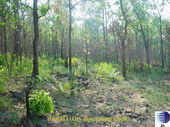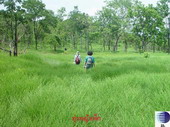
SERS ENVIRONMENT
GEOGRAPHY
The climate at SERS is tropical with no occurrence of frost. The winters are cool and dry, while the summers are hot and humid. Average maximum temperature is 35 ° C, and the average low is 16 ° C. The wet-season occurs from May to mid-October, with rainfall peaks in May and September. The average annual rainfall is 1200mm.
SERS occupies an area of 80km ² , (approximately 48, 750 rai), on the edge of the Khorat Plateau, at longitude 101 ° 51 east and latitude 14 ° 30 north. The stations grounds rise from 250m above sea-level to 762m at the top of its highest mountain, Khao Phiat. Mountains dominate the south-west region, with the slopes easing to smaller hills in the north-east. Bedrock is exposed only along streams and at the escarpments bounding SERS on the south-east, elsewhere there is heavy soil and vegetation cover. The entire area appears to be underlain with sandstone. No mineral deposits of economic importance have been found within the station boundaries, except for laterite soils which have been used for road construction.
VEGETATION
SERS has two major natural vegetation types. Both are primary forest, more than 400 years old. The majority of the vegetation is dense dry-evergreen forest, except for the north and northeast sections of the SERS where an open dry-dipterocarp forest occurs. Several small areas of bamboo, Areca sp. are found in the dry-evergreen forest at higher elevations. The boundary between the two types of forest is sharp; though between them narrow strips of transitional mixed deciduous vegetation can be found. The dry-evergreen forest is considered an intermediate between tropical rainforest and mixed deciduous. At SERS, the dry-evergreen forest has a dense, four-storey canopy. This forest dominates the south-west section of the station, extending north-east to cover 60% of the station. It includes species such as Hopea ferrea , Hopea odorata and Hydnocarpus ilicifolia . The dry-dipterocarp forest occupies the rolling hills in the north-east of the station; here sandstone boulders and laterite are common. It covers 18% of the station area. Dry-dipterocarp forests are open, generally consisting of uniformly spaced trees, with sparse foliage allowing the sun's ray to reach the ground. Vegetation in this forest is more seasonal, but common trees are Shorea obtusa , Dipterocarpus intricatus , Shorea siamensis and Gardenia sootepensis .
The remaining area is composed of reforested land (18%), grassland (1%), bamboo (1%), and the office and operational buildings (2%).
WILDLIFE
The natural vegetation at SERS supports a high faunal diversity. Some 430 vertebrate species are known to be present at SERS. While some animals are regular inhabitants of SERS, others pass through on migratory routes or move between SERS and the adjacent Khao Yai National Park .
There are around 230 birds which have been reported at SERS. The Siamese Fireback pheasant ( Lophura diardi ), also the symbol of SERS, is a common sight near the office and dormitory buildings, in the dry-evergreen forest. Other frequently encountered birds include the white-rumped shama ( Copsychus malabaricus ), hanging parrots ( Loriculus vernalis ), owlets ( Athene brama ), the greater racket-tailed drongo ( Dicrurus paradiseus ) and the crested serpent eagle ( Spilornis cheela ).
Nearly 80 species of mammals are known from SERS. This includes the serow ( Naemorhedus sumatraensis ), one of 15 species protected under Thai law due to their rarity and risk of extinction. Other mammals that occur at SERS but which are not seen frequently are the pangolin ( Manis javanica ), lesser mouse deer ( Tragulus javanicus ), civets, and bears. There are a number of mammals however, which are commonly seen in the forest near the roads and pathways. This includes the barking deer ( Muntiacus mantjak ), the Indochinese ground squirrel ( Menetes berdmorei ), pig-tailed macaque ( Macaca nemestrina ), slow loris ( Nycticebus coucang ) as well as various bat, rodent and flying squirrel species.
Numerous lizards and snakes inhabit the SERS forest, just fewer than 90 species. This includes commonly seen snakes like the big-eyed pit viper ( Trimeresurus macrops ), king cobra ( Ophiophagus hannah ), green cat snake ( Boiga cyanea ), and the green and red-necked keelback ( Rhabdophis subminiatus ). Less frequently seen snakes include pythons. Tookays ( Gekko gecko ) are frequently heard and seen around the buildings and forest. Other lizards found at SERS include the flying lizards ( Draco sp. ), butterfly lizards ( Leiolepis sp. ), slender-toed geckos ( Cyrtodactylus sp. ) and the Indo-Chinese water dragon ( Physignathus cocincinus ).
There are 26 amphibian species known from the SERS waterways. Tree frogs include the common treefrog ( Polypedates leucomystax ), the Chantaburi warted treefrog ( Theloderma stellatum ), and two Chirixalus species, Hansen's bushfrog and Nong Khor bushfrog. There are ten microhylid species, including the Truncate-snouted burrowing frog ( Glyphoglossus molossus ) and the Inornate froglet ( Micryletta inornata ).
In addition, there is a wide array of invertebrate species,
Please click on the links under the heading “Checklist of Species” for a full list of the species found at SERS.
 ddddd
ddddd 

::::::Sakaerat Environmental Research Station:::::